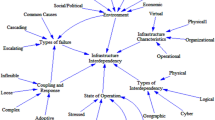Abstract—
The structure of an intelligent information system that has been designed to protect the network information system from unauthorized external influences by various parrying means is described. The conditions for the stable functioning of the network information system are presented. An optimization problem has been formulated, which consists in the need to minimize the negative external influence on the network information system using parrying means of the designed intelligent information system. This problem has been divided into four subproblems, analytical models have been created for their solution, algorithms have been developed, and two examples of analytical solutions of problems of optimal distribution of negative external influences by the elements of the network information system without taking the mutual influence of system elements into account and taking them into account are shown.


Similar content being viewed by others
REFERENCES
Gromov, Yu.Yu. and Tyutyunnik, V.M., Materials for the information theory elaboration. 1. Information quantity and quality measures, J. Int. Sci. Publ.: Mater. Methods Technol., 2011, vol. 5, no. 1, pp. 230–241.
Gromov, Yu.Yu. and Tyutyunnik, V.M., Materials to development of the information theory, part 1: Measures of quantity and quality of information, Fundam. Issled., 2011, no. 8-2, pp. 347–355.
Gromov, Yu.Yu., Tyutyunnik, V.M., and Minin, Yu.V., Materials to the theory of information elaboration. 2. Information as tensor quantity and information system modelling, Int. J. Res. Eng., IT Soc. Sci., 2018, vol. 8, no. 6, pp. 1–14.
Gromov, Yu.Yu., Tyutyunnik, V.M., and Minin, Yu.V., Materials to the theory of information elaboration. 3. Information systems modelling, in Materialy XVIII Mezhdunarodnoi nauchnoi konferentsii Formirovanie professionala v usloviyakh regiona: novye podkhody, Tambov, 2018 (Materials of the 18th Int. Scientific Conf. on Formation of a Specialist Under Regional Conditions: Novel Approaches), Tyutyunnik, V.M. and Zernov, V.A., Eds., Tambov: Mezhdunarod. Inf. Novelevskii Tsentr, 2018, pp. 87–106.
Gromov, Yu.Yu., Tyutyunnik, V.M., and Minin, Yu.V., Materials for the information theory elaboration. 4. Tensor measurement of information for information system modelling, in Informatsionnye sistemy i protsessy: Sb. nauchnykh trudov (Information Systems and Processes), Tyutyunnik, V.M, Ed., Tambov: Mezhdunarod. Inf. Novelevskii Tsentr, 2018, pp. 7–28.
Tyutyunnik, V.M., Gromov, Yu.Yu., and Aleksandrov, E.Yu., Analytical models of parrying negative external influences on a network information system, Autom. Doc. Math. Linguist., 2020, vol. 54, no. 5, pp. 250–254. https://doi.org/10.3103/S0005105520050040
Tyutyunnik, V.M., Gromov, Yu.Yu., and Aleksandrov, E.Yu., Analytical models of negative external influences vaporizing on the network information system, Autom. Doc. Math. Linguist., 2020, vol. 54, no. 5, pp. 250–254. https://doi.org/10.3103/S0005105520050040
Liang, X. and **ao, Ya., Game theory for network security, IEEE Commun. Surv. Tutorials, 2013, vol. 15, no. 1, pp. 472–486. https://doi.org/10.1109/SURV.2012.062612.00056
Gupta, M., Rees, J., Chaturvedi, A., and Chi, J., Matching information security vulnerabilities to organizational security profiles: a genetic algorithm approach, Decis. Supp. Syst., 2006, vol. 41, no. 3, pp. 592–603. https://doi.org/10.1016/j.dss.2004.06.004
Hashemi, S.M., He, J., and Basabi, A.E., Multi-objective optimization for computer security and privacy, Int. J. Network Secur., 2017, vol. 19, no. 3, pp. 394–405. https://doi.org/10.6633/IJNS.201703.19(3).08
Dewri, R., Poolsappasit, N., Ray, I., and Whitley, D., Optimal security hardening using multi-objective optimization on attack tree models of networks, in Proc. 14th ACM Conf. on Computer and Communications Security, Alexandria, Va., 2007, New York: Association for Computing Machinery, 2007, pp. 204–213. https://doi.org/10.1145/1315245.1315272
Firesmith, D.G., Common concepts underlying safety, security, and survivability engineering, Pittsburgh, Pa.: Carnegie Mellon Univ., 2003.
Author information
Authors and Affiliations
Corresponding authors
Additional information
Translated by O. Pismenov
About this article
Cite this article
Gromov, Y.Y., Tyutyunnik, V.M. Models for Assessing the Security of Network Information Systems against Negative External Influences. Autom. Doc. Math. Linguist. 55, 196–202 (2021). https://doi.org/10.3103/S0005105521050071
Received:
Published:
Issue Date:
DOI: https://doi.org/10.3103/S0005105521050071




